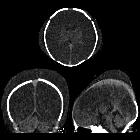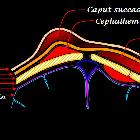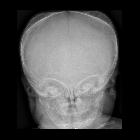Caput succedaneum


Newborn who
experienced prolonged labor. Axial (above), coronal (below left) and sagittal (below right) CT without contrast of the brain show a large low density fluid collection in the subcutaneous tissues of the scalp that crosses sutures and is seen to surround the skull on the coronal view. Intracranially, there is diffuse loss of gray matter-white matter differentiation secondary to diffuse cerebral edema.The diagnosis was caput succedaneum in a patient with hypoxic ischemic encephalopathy.

Newborn with
failure to progress during delivery due to dystocia who is now apneic. Axial CT without contrast of the brain shows a cresenteric high-density fluid collection in the subcutaneous tissues of the right scalp that crosses suture lines and a cresenteric low-density fluid collection in the subcutaneous tissues of the left scalp that crosses suture lines. Intracranially, there is diffuse loss of gray matter-white matter differentiation secondary to diffuse cerebral edema.The diagnosis was a left caput succedaneum and a right subgaleal hematoma in a patient with hypoxic ischemic encephalopathy.
Caput succedaneum is a manifestation of birth trauma, and it consists of a subcutaneous serosanguineous fluid collection external to the galea aponeurosis in the newborn's scalp. The fluid collection is extra-periosteal. It may be imaged with ultrasound, CT, or MRI.
Caput succedaneum results from pressure on the presenting part of the skull against the dilating cervix. It extends across the midline and over suture lines and is associated with head molding.
Caput succedaneum does not usually cause any complication and usually resolves over the first few days. Management is expectant.
Differential diagnosis
- scalp hematoma
- caput succedaneum
- subgaleal hematoma
- cephalohematoma
See also
Siehe auch:
und weiter:

 Assoziationen und Differentialdiagnosen zu Geburtsgeschwulst:
Assoziationen und Differentialdiagnosen zu Geburtsgeschwulst:


